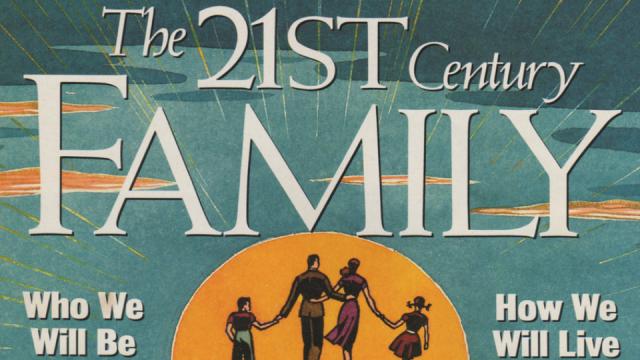Today was a historic day for equality, as the US Supreme Court struck down the misleadingly named Defense of Marriage Act (DOMA). Futurist thinkers have been imagining this day for years. Back in 1990, Newsweek gave hints about what marriage might look like in the world of tomorrow.
DOMA was signed into law in 1996 as a reactionary, bipartisan response to the slowly swelling tide of gay acceptance happening in the US during the early 1990s. As Newsweek put it in 1990, it was “surprising” that gay and lesbian couples (with and without children) were beginning to be recognised as families by the American public. Surprising or not, “mainstream” American culture in the 1990s was coming to realise that what constitutes a family couldn’t be defined by “Leave It To Beaver” or any other cultural touchstone that romanticised a familial past that never was.
The winter/spring special edition of Newsweek from 1990 is an interesting artefact from this pre-DOMA era. The magazine looked at the family of the 21st century in many of its different forms, including gay couples. While the magazine doesn’t promise that gay marriage is on the horizon, they profiled a few different families with same-sex partners, including a couple from California who had adopted two children:
Among these nontraditional parents are Michael Pesce, 35, and Jonathan Jarnig, 36. Pesce, a social worker, and Jarnig, a maitre d’ at a restaurant, live in a three-bedroom house in suburban Sacramento with their two kids, James, 7, and Carly, 5. Parenthood was always a compelling goal for both men; they even discussed it on their second date seven years ago. “I didn’t feel like a whole person without kids,” recalls Jarnig. “I didn’t feel it was right for gay people to be robbed of a sense of family.” The couple, whom the kids call Dad and Poppa, are among fewer than a dozen gay couples in the United States who have been granted “joint adoption,” which means both fathers have the same secure legal relationship to the children.
The magazine went on to explain just how normal (and boring) the couple was. The gays: they’re just like us!
“Our values really are the same as those of our parents,” says Jarnig. “We just happen to be two men.” “We’re really quite boring,” adds Pesce. “Just homebodies. We’re Ozzie and Harry.” Their home is one with rules and structure: no playing in the living room, cleaning up the family room after play, and no candy. But it’s also one with love and understanding for the children, who are Hispanic siblings. “It’s important to tell them every night that they’re valued and loved,” says Pesce.
In a sidebar to the story, Newsweek outlined the various rights of domestic partners that had been accruing in some progressive American cities since the late 1980s:
New York
In July 1989 the Court of Appeals held that a long-term, live-in gay couple may be considered a family under the state’s rent-control regulations.
San Francisco
In June 1989 the Board of Supervisors passed legislation recognising homosexual and unmarried heterosexual couples as families and allowed for registration of “domestic partners.”
Madison
In August 1988 the city council OK’d sick and bereavement leave to domestic partners of city employees and extended the right of domestic partners to live in single-family zones.
West Hollywood
In December 1988 the California city became “self-insured” and offered medical benefits to domestic partners, extending a 1985 ordinance permitting domestic partners official registration and hospital and prison visitation rights.
The article put the US family census figures into perspective for a 1990s audience. According to Newsweek’s citation of the latest figures at the time, 1.6 million same-sex couples were living together in 1988, and about a quarter of America’s 91 million households fit what the magazine called a “traditional” model for a family — one that we can guess means a heterosexual married couple with children.
But how those same-sex couples were counted obviously varied, since only about 150,000 same-sex couples were accounted for in the “same-sex unmarried partner” category in the official 1990 US census — far fewer than the 1.6 million number that Newsweek gave for just two years earlier.
Figures from the annual census reports underscore Leonard’s argument. Fewer than 27 per cent of the nation’s 91 million households in 1988 fit the traditional model of a family. At the same time, the bureau has counted 1.6 million same-sex couples living together, up from 1.3 million in 1970, and 2.6 million opposite-sex couples sharing a household, up from just half a million in 1970. Reasons cited for these demographic changes include divorce, delayed marriage and the growth of the gay-liberation movement. For now the Census Bureau still excludes most nontraditional arrangements from its “family” category. But Paul Glick, until 1981 the department’s senior demographer, thinks the federal legal definition of family could broaden considerably in the next 20 years.
And here we are, 23 years later with a definitive victory for marriage equality. Sure, there’s still plenty of work to be done at the state level to ensure that families are treated equally. But at least at the federal level, the retrofuture promise of marriage equality in the United States has finally arrived.
Picture: Newsweek special issue winter/spring 1990
